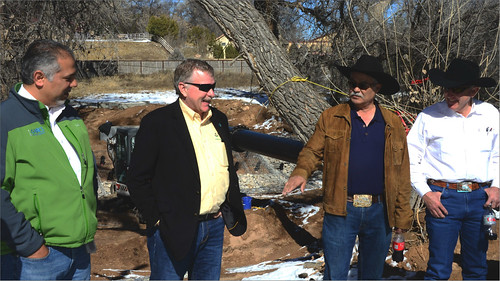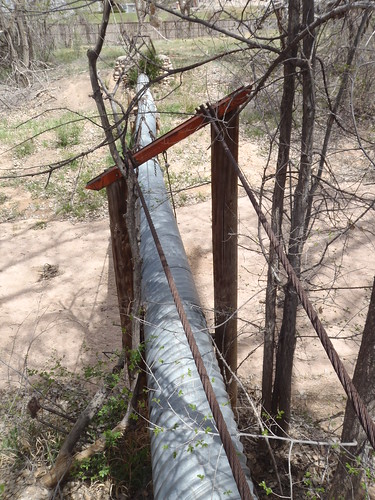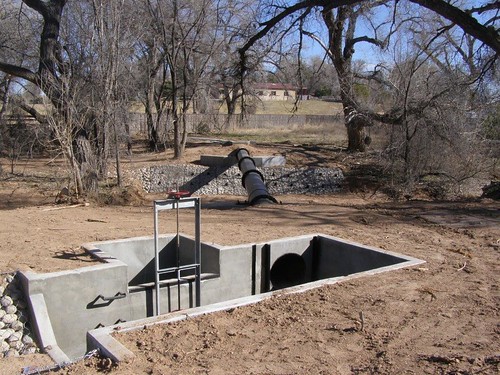
Xavier Montoya, State Conservationist for NRCS New Mexico (left) and Mark Rose (center left), NRCS director of financial assistance programs manager, talk about the successful partnerships and teamwork that led to the completion of the Las Joyas Acequia improvements near Nambe, New Mexico. Kenneth Salazar (center right), former president of the New Mexico Association of Conservation Districts and current President Jim Berlier (far right).
Spaniards built the Acequia de Las Joyas approximately 300 years ago. The acequia, a community irrigation watercourse or ditch, was the principal method of providing water to the farmers for their crop and rangelands in northern New Mexico. The parciantes (also known as acequia members) worked together to maintain the acequia and each member in return received a portion of the water.
Three centuries later, the practice is still key to making the land bloom. But, time and the elements have taken their toll on acequia and repair costs have escalated to the point that members can no longer shoulder the burden of maintaining the critical community resource alone.
In Santa Fe, USDA’s Natural Resources Conservation Service (NRCS) has been able to fill the gap, making it possible for members to revitalize the Acequia de Las Joyas using welded steel pipe and a concrete-lined watercourse to replace an aged, leaking flume structure with failing joints.

Before image of a sluice structure, flume and concrete lined ditch to convey water to the landowners downstream.
“It helps by allowing us to better use our water―our resource. In fixing the flume structure, we can run more water, more efficiently,” said Doug Hefele, an officer of the Acequia de Las Joyas. “We may be able to water more than one parciantes at a time.”
The repaired structure not only conserves water, but increases the quantity of water flowing through the flume―making more water available for the parciantes to irrigate their farmland.
The Acequia de Las Joyas was the first project approved in the country through the Regional Conservation Partnership Program (RCPP)―administered by NRCS in all 50 states and the Commonwealth of Puerto Rico. Through RCPP, NRCS and its partners help producers improve conservation practices and maintain conservation activities in eligible areas.
RCPP draws on local knowledge and networks to fuel conservation projects. Bringing together a wide variety of new partners including businesses, universities, non-profits and local and Tribal governments makes it possible to deliver innovative, landscape- and watershed-scale projects that improve natural resource concerns on working farms, ranches and forests.
Cooperation between NRCS, the Interstate Stream Commission, the New Mexico Association of Conservation Districts, the New Mexico Acequia Association and acequia parcientes, allowed a traditional irrigation method to continue serving the community.
Agriculture Secretary Tom Vilsack recently announced the availability of up to $260 million for RCPP partner proposals to improve the nation’s water quality, combat drought, enhance soil health, support wildlife habitat and protect agricultural viability. The funding will add to the nearly $600 million NRCS has invested in 199 partner-led projects since 2015.
This will be the third round of projects funded through RCPP, helping USDA build on record enrollments in voluntary conservation programs, with more than 500,000 producers participating to protect land and water on more than 400 million acres nationwide.
USDA is now accepting proposals for Fiscal Year 2017 RCPP funding. Pre-proposals are due May 5. For more information on applying, visit the RCPP website.

After image of a sluice structure, flume and concrete lined ditch to convey water to the landowners downstream.
No comments:
Post a Comment
Note: Only a member of this blog may post a comment.